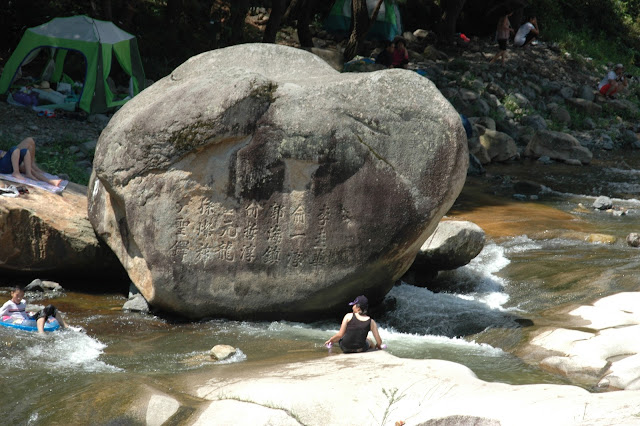Jak-chun-jung & Jakkwaecheon valley of Ulju's 8 Sceneries
The stream runs from 1,083m Gan-wol mountain over the sea to the front of Jak-chun-jung passing Dung-uk-ri, we call it Jak-goae-chun. From old times it is an oasis in Eonyang due to its clear water and beautiful scenery.
Drive 3km from Eonyang to the central-south and turn to the west road, we can meet tunnel of cherry trees aged 40 years, after passing this tunnel, we can see Jak-chun-jung.
Its name is started because of purity of water and rock just like dangled liquor glasses. You can feel great scene of many grand, strange rocks in both side of valley after parking at the entrance parking lot. crystal water runs on worn-out crags. Even if it''s severe hot sultriness, we may forget about it through washing hand and our face. Jak-chun-jung is an arbor, which was built by local scholars to praise King Se-jong of Cho-sun age in the 20th year after coming to the throne, it''s a beautiful spot matched with clear water and white rocks. Becoming cool at this arbor, we may feel like to compose a poem or paint this beauty into a picture. In fall, we can appreciate the beauty of whole blazing mountain. Many poets and painters has visited here from old times.

But not always under romantic mood. This place was used for a plan about the 1919 Independence Movement, many local troops were dead in battle during Japanese Invasion of Korea in 1592 and also it was open-air church when the religion of Chondokyo, Roman Catholic come in first. Like this, it was a nest for many patriots, a sprouting place to fixation of religions and a place where many poets and painters developed studies. -transportation Buses run from Eonyang every 15 minutes and it takes 15 minutes to Jak-chun-jung.(30 minutes from Ul-san to Eonyang by bus)

Drive along Kyung-bu Highway, more 4km on #35 national road passing Eonyang town from Eonyang IC, or go up to Jak-chun-jung through Tong-do-sa IC along Kyung-bu Highway.
Location : Gyodong-ri, Samnam-myeon, Ulju-Gun, Ulsan
The stream runs from 1,083m Gan-wol mountain over the sea to the front of Jak-chun-jung passing Dung-uk-ri, we call it Jak-goae-chun. From old times it is an oasis in Eonyang due to its clear water and beautiful scenery.
Drive 3km from Eonyang to the central-south and turn to the west road, we can meet tunnel of cherry trees aged 40 years, after passing this tunnel, we can see Jak-chun-jung.
Its name is started because of purity of water and rock just like dangled liquor glasses. You can feel great scene of many grand, strange rocks in both side of valley after parking at the entrance parking lot. crystal water runs on worn-out crags. Even if it''s severe hot sultriness, we may forget about it through washing hand and our face. Jak-chun-jung is an arbor, which was built by local scholars to praise King Se-jong of Cho-sun age in the 20th year after coming to the throne, it''s a beautiful spot matched with clear water and white rocks. Becoming cool at this arbor, we may feel like to compose a poem or paint this beauty into a picture. In fall, we can appreciate the beauty of whole blazing mountain. Many poets and painters has visited here from old times.

But not always under romantic mood. This place was used for a plan about the 1919 Independence Movement, many local troops were dead in battle during Japanese Invasion of Korea in 1592 and also it was open-air church when the religion of Chondokyo, Roman Catholic come in first. Like this, it was a nest for many patriots, a sprouting place to fixation of religions and a place where many poets and painters developed studies. -transportation Buses run from Eonyang every 15 minutes and it takes 15 minutes to Jak-chun-jung.(30 minutes from Ul-san to Eonyang by bus)

Drive along Kyung-bu Highway, more 4km on #35 national road passing Eonyang town from Eonyang IC, or go up to Jak-chun-jung through Tong-do-sa IC along Kyung-bu Highway.
Location : Gyodong-ri, Samnam-myeon, Ulju-Gun, Ulsan








